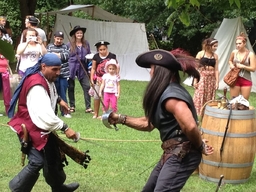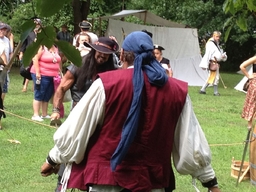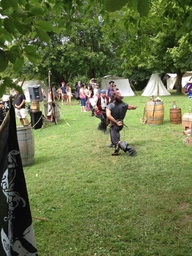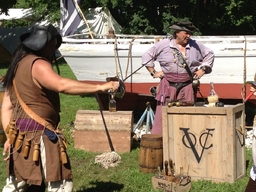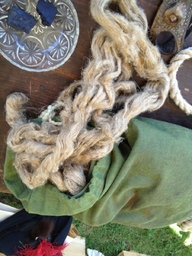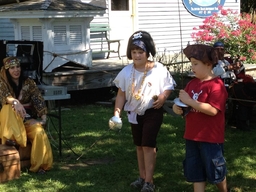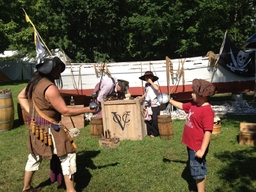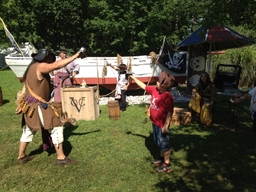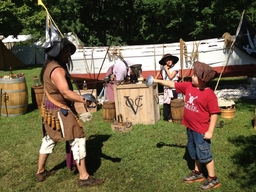-
Posts
652 -
Joined
-
Last visited
Content Type
Profiles
Forums
Events
Gallery
Everything posted by Daniel
-
-
From the album: Rock Hall 2013
-
From the album: Rock Hall 2013
-
From the album: Rock Hall 2013
-

Brandon attacks The Marquis d'Eglise Two handed
Daniel posted a gallery image in Pub Members Gallery
From the album: Rock Hall 2013
-
From the album: Rock Hall 2013
-
From the album: Rock Hall 2013
-
From the album: Rock Hall 2013
-
From the album: Rock Hall 2013
-
From the album: Rock Hall 2013
-
From the album: Rock Hall 2013
-
From the album: Rock Hall 2013
-
From the album: Rock Hall 2013
-
From the album: Rock Hall 2013
-
From the album: Rock Hall 2013
-
Pretty darn good. This is in the top 25% or so of the pirate fiction I've read on this board, and has some definite potential. I was particularly pleased with the prologue, which gives the illusion at first that this is going to be yet another rebellious-daughter-versus-heartless-domineering-mother story, and then immediately upends my expectations. Anne Bonny promises to be a unique and unpredictable character; I'm not at all sure that I like her, but I am quite sure that I am intrigued by her. I'm not going to say that this would be publishable as yet, which requires quality in the top 5% range or so, and even then is as much a matter of persistence and luck as quality. It sure does stand out, though. I would be willing to offer you some line by line criticism, if you would like to have it. I want to ask first, because my criticism can be pretty bruising on the ego. But please understand that I wouldn't be offering this if I weren't pretty impressed with your work and consider it worth the time and effort to improve. And I am certain that I can help you improve your dialogue and avoid certain anachronisms.
-
Hope you'll enjoy your time here. Good to meet you.
-

The statues at the front of ships... (figureheads)
Daniel replied to JS1990's topic in Captain Twill
Those statues are called figureheads. Most likely they were once thought to help the ship find her way, much like the eyes that used to be painted on ancient Greek and Phoenician ships, and over time they evolved into general symbols of good luck. They were individual to each ship, no special relationship to the country the ship sailed for. They were occasionally related to the ship's name; I have seen a painting of Drake's Golden Hind with a golden deer (hind) for a figurehead. The Golden Hind's name was changed from the Pelican, and I don't know if they changed the figurehead when they changed the name. But that was unusual; seamen thought it was bad luckt o change a ship's name, so it was rarely done. -
Sure. I'll add a list of tropes to the end of each review, and then after some time I'll be able to trace the emergence of some of the tropes. (I still do not recall ever having heard "scalawag" in a pirate movie before POTC: The Curse of the Black Pearl).
- 34 replies
-
- movies
- pirate art
-
(and 3 more)
Tagged with:
-
TREASURE ISLAND (2012) Directed by Steve Barron. Featuring: Eddie Izzard, Toby Regbo, Rupert Penry-Jones, Daniel Mays, Philip Glenister, Donald Sutherland, Elijah Wood, Shirley Henderson, Nina Sosanya, Geoff Bell, Shaun Parkes, David Harewood. Rating (from 1 to 5): 2 Most adaptations of Treasure Island have stuck to well-charted waters, with low risk and low reward. Steve Barron strikes out into unknown soundings, which makes for a more exciting voyage at first, but ultimately he strikes a reef and sinks. Stevenson’s story is still there in outline. Young Jim Hawkins finds Captain Flint’s treasure map, evades the pirates who are looking for it, and takes it to his friend Dr. Livesey. Livesey in turn takes it to Squire Trelawney, who is not Livesey’s friend here, but instead a rich merchant and the financial backer of Jim’s Admiral Benbow Inn. Livesey turns to Long John Silver to hire his crew, not knowing that Silver is one of Flint’s pirates. Silver prepares to take the treasure for himself and his old comrades. Trelawney cheats Jim and Livesey out of their share in the treasure, and the embittered Jim agrees to steal the treasure map for Silver. Barron makes an incredibly bold decision here: to dethrone Long John Silver, one of the iconic villains of English literature, from his place as the story’s antagonist. Trelawney, not Silver, is Barron’s true villain, essentially a Lehman Brothers executive of the 18th century driven mad by greed and, like a Lehman Brothers executive, ruining everybody around him as well as himself. By the end, the movie seems to be saying more about the 2008 financial meltdown than about Jim Hawkins’s battle for manhood. This is certainly an interesting tack to take on Stevenson’s old story, but unfortunately, Barron did not fully calculate the consequences of his decision. By making Trelawney the villain, and further reducing Livesey to an emasculated, hollow shell of himself, Barron has deprived Jim Hawkins of his role models. In the novel and in most previous film adaptations, Jim’s supreme moment is when he stands by his word to Long John Silver, even at the risk of torture and death, because he knows it is what the squire, the doctor, and the captain would do in his place. Jim becomes a man by the stockade wall when he rejects Dr. Livesey’s offer to relieve Jim of responsibility for his own actions. This scene never happens in Barron’s movie. Instead, Jim’s defining moment is at the very end, when he apparently decides that the corpses floating in the story’s wake were caused not by human greed and disloyalty, but by the treasure itself. He then acts accordingly. This is just stupid, and the fact that most of the other characters go along with it is stupider still. Meanwhile, Trelawney’s shoulders are simply not broad enough to carry the dramatic weight that Silver carried. A story is only as good as its villain, and Trelawney is too weak, hysterical and irrational to make us truly fear and respect him the way we feared and respected Silver. Another major change in this version is the new prominence of Silver’s wife Alibe. Stevenson stints her a name; she is just called Silver’s “old Negress,” and I imagined her as a plump, matronly woman of Silver’s age. It was fascinating to see her rendered as a slender, sensual, though slightly worn beauty. Mrs. Silver here joins Jim’s mother at the Admiral Benbow and the two of them struggle to survive without the men they depend on. This was an interesting idea, but it goes nowhere: the two women achieve absolutely nothing, and do not affect the plot’s course at all. The final nail in the coffin is how this movie treats Silver. It’s not Eddie Izzard’s fault; he plays the role well, with a soft-spoken deference that makes Jim’s and Trelawney’s trust in him entirely believable. But Silver, a cripple, controls his old mates by two means – menace and brilliance – and the decision to soft-pedal the menace makes the brilliance absolutely essential. But instead of brilliance, we get tactical chump moves, the worst of which is Silver’s decision to ask Jim Hawkins for the map while still en route to the island. Silver never takes this huge risk in the novel, because he doesn’t need to. He intends to let Trelawney and Livesey find the treasure themselves, load it on board, and then slit their throats – an admirably simple plan that would have worked but for the lucky chance of Jim Hawkins overhearing it. Too, Barron’s Silver is vacillating and indecisive in the face of the premature mutiny aboard the Hispaniola, lacking the sure intelligence and instinct of his counterpart in the novel. In another interesting but poorly handled decision, Barron decides to make three of the major officer characters black: Billy Bones, George Merry, and Mr. Arrow, all of whom are first mates. This could have worked, but Barron simply ignores the elephant in the room. The story is set in the 1740s, when racist justifications for slavery and the slave trade had taken full hold in England and America. The vast majority of European whites at that time believed that black people were inferior and unfit to command white men. The fact that we have three black mates anyway is conceivable, but it requires explanation; there has to be some reason why these three black men are not being treated the way most black men were at the time. And we are never told that reason, leaving an anachronistic flavor in our mouths. This is unfortunate, because the decision to show the ordinary seamen themselves as ethnically diverse is quite historically accurate (the crews of Woodes Rogers’ Duke and Duchess were over one third non-English), and a welcome change from previous movies. It’s a shame to see such a beautiful set of production values stranded on the rocks. The Hispaniola is magnificent – a full-rigged ship rather than a schooner here. The sequence of her setting sail for the island as her crew chants an Afro-Jamaican sea shanty is unique and stunningly beautiful. The costumes are magnificent and colorful, aided by the good decision to portray a motley crew from all over the world (although it is a bit strange to see Israel Hands apparently wearing chain mail). The fight scenes are well choreographed, with Trelawney’s panic amusingly portrayed. I hate to knock Barron’s Treasure Island so hard. In a time when artistic boldness is so rare in movies, Barron really made a lot of gutsy moves. But if you want to be captain, or director, you need to be cunning like Silver, not just brave like Trelawney.
- 34 replies
-
- movies
- pirate art
-
(and 3 more)
Tagged with:
-
I have the modest goal of seeing and reviewing every pirate movie ever made. I will try to post one review a month. I will start by reviewing as many versions of Treasure Island as I can.
- 34 replies
-
- movies
- pirate art
-
(and 3 more)
Tagged with:
-
Edward Low used a green flag with a yellow trumpeter on it to summon his ships together for conference. At closer range, his quartermaster John Russell used a speaking trumpet to shout orders at his victims, and I would assume that would be used to communicate between ships also. That's the only example I know specifically of pirates communicating with other pirate ships at a distance, but there were several methods of signaling other ships that were commonly understood long before the Napoleonic-era signal flags were introduced. For example, tying a "wiff" knot in one's flag was universally understood as a signal to come aboard and give help; Stede Bonnet's pirates mocklingly used this signal to their enemies aboard the Henry in the battle of the Cape Fear River, as a challenge to board them. Rhett's men understood the signal and shouted that they would come aboard by and by. In another case, Henry Every wished to avoid confrontation with the Royal Navy, so he left a message for English ships to signal their identity by rolling up their ensign into a bundle and flying it at the mizzen peak, so he would know to leave them alone. I don't know if this signal was ever actually used, though. Of course, if we credit Richard Hawkins' old story that the black flag was a promise of mercy while a red flag meant no quarter, then the red flag would have functioned as a signal to any other pirate ships in the fleet that they too should offer no quarter. It doesn't make much sense to warn your victims that you're going to offer no quarter; all that does is steel them to fight to the last man, so it only makes sense as a signal to fellow pirates.
-
I will be there, possibly with family. I intend to bring salmagundi and a bottle of rum punch. Any Pubsters going too?
-
Foxe and I talked a little about this in this thread: http://pyracy.com/index.php/topic/16862-prize-money-questions/ . He said that before 1708, privateer prizes were normally condemned to be sold in a regular Vice-Admiralty court, as opposed to the specialized prize courts set up by the Cruizers and Convoys Act. We didn't actually discuss whether naval prizes were condemned in the same way, but I assume they must have been. On privateers, though, the distribution of the money would have been regulated by the articles of the individual privateer, which always guaranteed a large portion for the men (no purchase, no pay and all that). On naval vessels, there weren't any individual articles on each ship, and I'm not sure Blake's Laws of War and Ordinances of the Sea said anything about how to distribute money from captured prizes.


